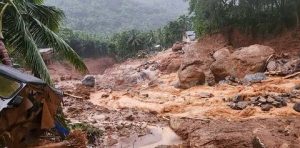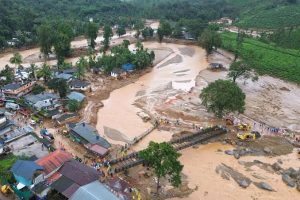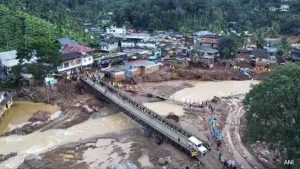Digital News Guru Kerala Desk:
Wayanad Landslides Declared ‘Severe Nature’ Disaster
The Union Home Ministry of India has officially declared the landslides in Wayanad, Kerala, as a disaster of ‘severe nature.’ This announcement comes five months after the catastrophic events of July 2024, when torrential monsoon rains triggered devastating landslides across the Chooralmala and Mundakkai regions. This classification is expected to expedite central assistance, providing much-needed relief and rehabilitation to the thousands affected.
The Disaster and Its Impact
The Wayanad landslides have been one of the most devastating natural disasters in Kerala’s recent history. Continuous heavy rains in the Western Ghats caused massive soil erosion, resulting in landslides that swept away entire villages. The tragedy has left an indelible mark on the region and its people.

Key Statistics of the Disaster:
- Fatalities: 254 confirmed deaths
- Injuries: 397 individuals injured
- Missing Persons: 47 still unaccounted for
- Displaced Population: Over 10,000 individuals
- Estimated Loss: 1,200 crore in damages
The disaster destroyed homes, agricultural lands, and vital infrastructure, plunging the affected communities into despair. Many residents lost their livelihoods, and the displacement caused significant disruptions to their daily lives.
Classification as a Disaster of ‘Severe Nature’
The designation of the Wayanad landslides as a disaster of ‘severe nature’ marks a critical step in addressing the aftermath of this calamity. This classification, based on an assessment conducted by the Inter-Ministerial Central Team (IMCT), recognizes the scale and intensity of the destruction.
What This Classification Entails:
- Increased Central Assistance:
The ‘severe nature’ designation makes Wayanad eligible for additional financial aid and resources from the central government. This funding will be instrumental in bolstering relief and rehabilitation efforts. - Focus on Rehabilitation:
The recognition emphasizes the importance of long-term measures to rebuild the affected areas, restore livelihoods, and improve resilience against future disasters. - Prioritization of Relief Efforts:
With official acknowledgment of the disaster’s severity, both the state and central governments are expected to expedite relief operations and infrastructure restoration.
Despite these developments, the Centre has yet to respond to Kerala’s request for a special rehabilitation package, leaving many in the region anxious about the next steps.

Government and Community Response
The Kerala government has been actively working to address the crisis since the landslides occurred. Relief camps were set up to accommodate displaced families, and immediate assistance was provided to those in need. However, the scale of the disaster has necessitated support from the central government.
Efforts Undertaken So Far:
- Relief Camps: Temporary shelters have been established for the displaced population, providing food, medical aid, and basic necessities.
- Damage Assessment: Local authorities, in collaboration with the IMCT, conducted surveys to assess the extent of damage to property and infrastructure.
- Financial Assistance: Initial relief funds were disbursed to affected families, but more substantial aid is awaited.
At the community level, local organizations and volunteers have played a crucial role in supporting relief efforts. Their contributions, combined with government initiatives, have brought some solace to the victims.
Challenges in Recovery
The path to recovery in Wayanad is fraught with challenges. The disaster has left behind a trail of destruction that requires substantial financial, technical, and logistical resources to overcome.
- Rehabilitation of Displaced Families:
Many of the displaced are yet to find permanent housing. Rebuilding homes and resettling families in safer locations is a complex and resource-intensive process. - Restoration of Livelihoods:
Wayanad is an agrarian region, and the loss of fertile land has severely impacted the livelihoods of farmers. Comprehensive measures are needed to restore agricultural activities and support alternate sources of income. - Infrastructure Repair:
Roads, bridges, and public utilities have been destroyed or severely damaged. Restoring connectivity and ensuring access to essential services is a top priority. - Environmental Concerns:
The landslides have exacerbated ecological vulnerabilities in the region. Reforestation and soil conservation measures are critical to preventing future disasters.
Need for a Long-Term Strategy
The Wayanad landslides underscore the urgent need for improved disaster preparedness and mitigation strategies in Kerala and other vulnerable regions. Climate change and deforestation have heightened the frequency and intensity of such events, demanding proactive measures to safeguard lives and livelihoods.
Proposed Measures:
- Strengthening Early Warning Systems: Investing in advanced weather forecasting and early warning mechanisms to alert communities in time.
- Sustainable Land Use Practices: Promoting afforestation and discouraging construction in ecologically sensitive zones.
- Disaster-Resilient Infrastructure: Ensuring that infrastructure development in vulnerable areas adheres to stringent safety norms.
- Community Training: Empowering local communities with knowledge and skills to respond effectively during emergencies.
Looking Ahead
The designation of the Wayanad landslides as a disaster of ‘severe nature’ is a step in the right direction, but its success depends on timely and effective implementation of relief and rehabilitation measures. The collaboration between the central and state governments will be pivotal in ensuring that the affected communities can rebuild their lives.

For the people of Wayanad, hope lies in the promise of a comprehensive recovery plan that addresses both immediate needs and long-term resilience. As Kerala continues to recover from this tragedy, the lessons learned from this disaster must guide future policies and actions to mitigate the impact of similar events.
In the face of adversity, the resilience and determination of the Wayanad community stand as a testament to the human spirit. With coordinated efforts and adequate support, the region can emerge stronger, paving the way for a safer and more sustainable future.
You May Also Read: SpaDeX Success: ISRO’s Bold Step Toward Autonomous Spacecraft Docking








